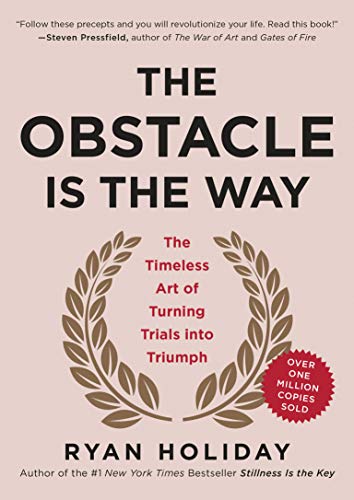Key quote: “The impediment to action advances action. What stands in the way becomes the way.” Marcus Aurelius
Key concepts:
Perception: Take control over how you perceive events in your life to find the opportunity within the obstacle. Use tools such as objectivity, cool-headedness (versus emotion), perspective, context and framing, and living in the present moment.
Action: Discipline yourself to take action – get going! Move in the direction you have set and vanquish setbacks with persistence. Focus on the present event versus worrying about the future. Know and practice what works for you, even if others take another approach. Your goal is to do your best job and use the obstacle against itself.
Will: Nurture the inner armor of a quietly steadfast will – humility, perseverance, resilience – preparing for the worst, embracing what is in your control and releasing what is not, confronting obstacles as opportunities, and then moving to the next (inevitable) challenge with equanimity.
Part I: Perception
Living in the present moment affects our perception, as well. Embrace the present through exercise, a leisurely walk, meditation, or adopting a pet. These actions will allow you to recognize how pleasing the present really is (p. 48).
Perception is how we view and interpret what happens around us, and our perceptions can be either a positive or negative influence in our lives (p. 11). Holiday urges leaders to be disciplined in how they perceive events in life so that they can be objective, control emotion, put things into perspective, and plan a course of action (p. 18).
Leaders can and should recognize what they really have control over, regardless of what friends, coworkers, or their own thoughts might say (p. 23). It is essential to steady the mind. Leaders need to do this, so they have the grace and poise to skillfully confront an issue (p. 25). Logic operates in service of these goals, defeating emotions by using questions and statements to arrive at the truth (p. 30).
One important aspect of practicing objectivity is to step back and see only what is there – not more, not less (p. 32). For example, we experience objectivity in action when we give others good advice. When it is not personal to us, we are able to remove ourselves from the equation and evaluate a situation (p. 34). One tool to help adjust perspective is to recognize the leverage of context (big picture) or framing (interpretation of events) (p. 38).
A good leader strives to find the opportunity within the obstacle. “The struggle against an obstacle inevitably propels the fighter to a new level of functioning” (p. 57).
Part II: Action
Disciplined action is a hallmark of a successful leader. “It doesn’t matter what happens to you or where you came from. It matters what you do with what happens and what you’ve been given” (p. 68).
Holiday urges us to emulate great leaders by making the most of momentum. Once we get started, we have the momentum to continue and make it work (p. 72). We all encounter setbacks, and when we do, we can practice persistence by working twice as hard (p. 81).
Failure isn’t the final word. Use failure to improve, learn, and try something new (p. 82).
Follow the process by focusing on right now and not worrying about what might happen later (p. 92). Do the job before you to the best of your ability with hard work, honesty, and while helping others (p. 95).
Holiday encourages leaders to stick with what works for them. “There’s a lot of pressure to try to match people move for move, as if sticking with what works for you is somehow cheating. Let me save you the guilt and self-flagellation: it’s not” (p. 107).
Use obstacles against themselves. Passive resistance can be very active when you exercise discipline and self-control (p. 113). You’re best able to channel your energy when you combine physical looseness with mental restraint (p. 117).
Part III: Will
The will is our internal power that is not affected by the outside world. It is demonstrated with quiet humility, resilience, and adaptability (p. 125). Will gives us the strength to persevere, contextualize, and interpret the obstacles that we cannot easily overcome (p. 130-131).
The leader builds up inner armor so that they are strong, resilient, and ready for anything (p. 137). Successful leaders anticipate that things will not always go their way. We only have control over ourselves and our emotions, not those of the people around us (p. 141).
Practice the art of acquiescence: some things lie outside of our control. In these circumstances, it is far better to accept and move on (p. 146).
Show gratitude for everything that happens in life, whether it is desirable or undesirable. Understand that obstacles present us with opportunities and benefits to learn and improve (p. 154).
Finally, when you pass one obstacle, prepare to start again. You’ll get better with every attempt (p. 173).

There is a world much bigger than you. People have dealt with worse, and each of us, at some point in our lives, will be subject to some random act or incomprehensible event (p. 166). Remembering our mortality gives us the opportunity to have real perspective and real urgency (p. 170).
Holiday, R. (2014). The Obstacle Is the Way: The Timeless Art of Turning Trials into Triumph. Portfolio/Profile Books.
